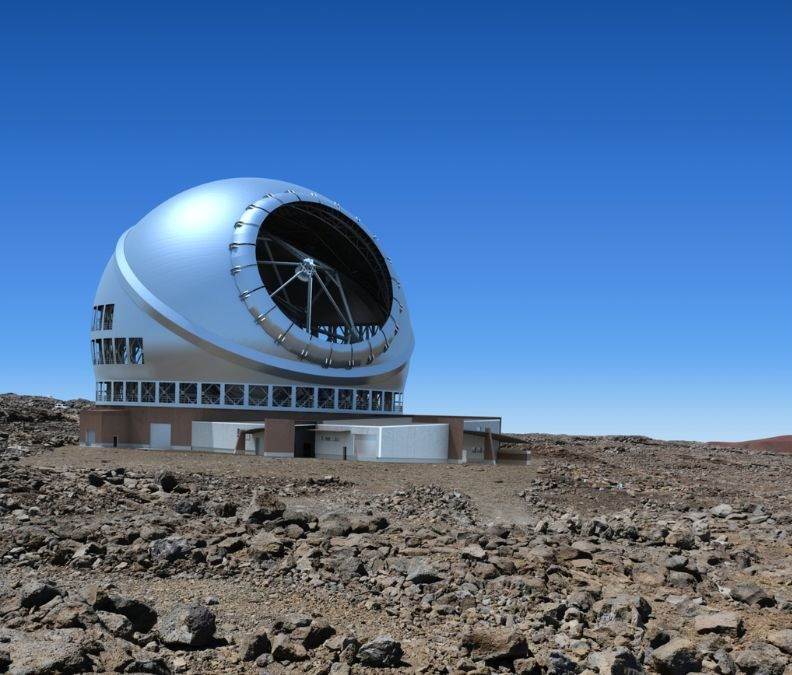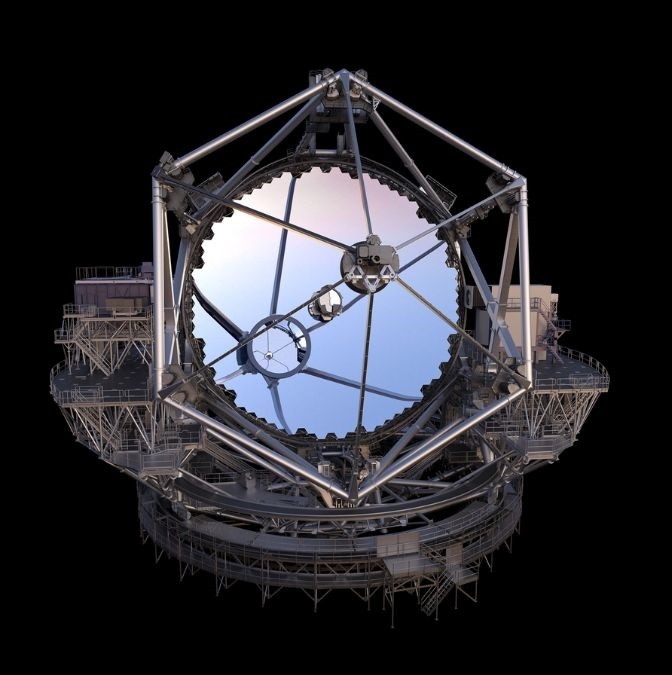Indian scientists have developed an open-source tool to generate an infrared star catalogue for the Adaptive Optics System (AOS) for the Thirty Meter Telescope (TMT). This advancement is crucial for the telescope's ability to accurately generate sharper astronomical images.
At present, there is no existing infrared star catalogue for all sky regions. This underscores the essential need for the new tool developed by Indian researchers to create a comprehensive all-sky Near Infrared (NIR) star catalogue.
In this article, we will learn what is the Thirty Meter Telescope (TMT), its scientific goals and features along with India’s role in the project.
When is Next Solar Eclipse in 2024, 2025 and 2026?
What is the Thirty Meter Telescope?
 Artist's render of the Thirty Meter Telescope; Image: TMT International Observatory
Artist's render of the Thirty Meter Telescope; Image: TMT International Observatory
The Thirty Meter Telescope (TMT) is an ambitious international project involving India, the United States, Canada, China, and Japan. The TMT is a next-generation astronomical observatory designed to significantly advance our understanding of the universe by providing unprecedented resolution and sensitivity.
The concept for the TMT was initiated in the early 2000s, with construction initially planned to start in 2014. However, various challenges have delayed its progress. The preferred site for TMT is Mauna Kea, Hawaii, one of the world's premier astronomical sites.
The primary goal of the TMT is to address fundamental questions about the cosmos, such as the nature of dark matter and dark energy, the formation and evolution of galaxies, and the potential for life on exoplanets.
The TMT will achieve its objectives through its massive 30-meter primary mirror, advanced adaptive optics system, and state-of-the-art instruments that will allow it to observe the universe in unprecedented detail.
Science Quiz On Space Debris With Answers
Scientific Goals of the TMT
The TMT aims to tackle some of the most profound questions in modern astronomy:
Study the Early Universe: TMT aims to explore the nature and composition of the universe, including understanding the formation and evolution of the first galaxies and stars after the Big Bang.
Galaxy Formation and Evolution: It seeks to investigate the formation, structure, and evolution of galaxies across cosmic time, helping to unravel the processes that shape their development.
Black Holes and Galaxy Relationships: TMT aims to study the relationship between supermassive black holes and their host galaxies, probing how these cosmic giants influence each other's evolution.
Stellar and Planetary Systems: TMT will investigate the formation of stars and planetary systems, shedding light on the conditions and processes that lead to the birth of planets around stars.
Extrasolar Planets: It aims to characterize extrasolar planets, studying their atmospheres, compositions, and conditions for potential habitability.
Search for Life Beyond Earth: TMT will contribute to the search for life beyond our solar system, exploring exoplanetary systems and assessing their potential for hosting life.
Fundamental Physics: The telescope also aims to test fundamental physics theories, such as those related to gravity and the behaviour of matter under extreme conditions.
What is Space Junk (Debris) and why is it a global threat?
Key Features of the TMT
Below are the key scientific features of the Thirty Meter Telescope (TMT):
Mirror System
Primary Mirror: The TMT boasts a massive primary mirror that spans 30 meters (98 feet) in diameter. This segmented mirror is composed of 492 hexagonal segments, each about 1.44 meters (4.7 feet) across.
Secondary Mirror: Positioned above the primary mirror, the secondary mirror is also segmented, consisting of 118 smaller hexagonal segments. The secondary mirror reflects the light from the primary mirror.
Tertiary Mirror: A substantial flat mirror, measuring 3.5 meters by 2.5 meters (approximately 11 ½ feet by 8 feet), positioned centrally within the primary mirror will ensure that the light collected by the primary and secondary mirrors is efficiently transferred to the scientific instruments for detailed analysis and observation.
Adaptive Optics System
The TMT is equipped with an advanced Adaptive Optics System (AOS) known as the Narrow Field Infrared Adaptive Optics System (NFIRAOS). This system uses a combination of deformable mirrors and laser guide stars to correct for atmospheric turbulence, significantly enhancing image resolution.
The NFIRAOS can create artificial guide stars by projecting laser beams into the sky, enabling precise real-time adjustments to compensate for atmospheric distortions. Indian scientists have developed an open-source tool to generate a comprehensive all-sky catalogue of Near Infrared (NIR) stars for the Adaptive Optics System (AOS).
Scientific Instruments
 Credit: TMT International Observatory
Credit: TMT International Observatory
The TMT will be equipped with a suite of first light and second generation instruments designed for various types of observations including detecting and characterizing the atmospheres of exoplanets. These include:
First Light Instruments:
- Infrared Imaging Spectrometer (IRIS
- Wide-Field Optical Spectrograph (WFOS)
- Multi-Objective Diffraction limited High Dispersion Spectrograph (MODHIS)
- Narrow Field Infrared Adaptive Optics System (NFIRAOS)
Second Generation Instruments:
- High-Resolution Optical Spectrometer (HROS)
- Near-Infrared Spectrometer (NIRES)
- InfraRed Multi-slit Spectrometer (IRMS)
- Multi-IFU Imaging Spectrometer (IRMOS)
- b-MICHI Mid-infrared Spectrometer Imager (MIRES)
- Planetary System Instrument (PSI)
- Astronomical Rapid Imager and Spectropolarimetric Explorer (ARISE)
What is a Black Hole? Which Is The Biggest Black Hole In The Universe?
India's Role in the Thirty Meter Telescope
Telescopes on the Earth's surface face the challenge of atmospheric distortion, which can significantly affect the quality of captured images. This issue is especially critical for telescopes with high light-collection capacities, such as the Thirty Meter Telescope (TMT), which are sensitive to upper atmospheric disturbances.
To mitigate these distortions, the TMT will employ an Adaptive Optics System (AOS) that continuously detects and compensates for atmospheric changes to produce high-quality images. A comprehensive all-sky catalogue of Near Infrared (NIR) stars is vital for this purpose.
Dr. Sarang Shah from the Indian Institute of Astrophysics (IIA) explained, "The Adaptive Optics System on the TMT, called the Narrow Field Infrared Adaptive Optics System (NFIRAOS), will benefit from a Laser Guide Star (LGS) facility."
This facility will project up to nine lasers into the sky, creating artificial guide stars. However, atmospheric turbulence affects these laser beams, so measuring atmospheric tip-tilt is uncertain. To correct these effects, the AOS requires feedback from three real stars, known as Natural Guide Stars (NGS).
Researchers at the IIA in Bengaluru, along with their collaborators, have developed an automated code that can be used as an online tool to generate a catalogue of NIR stars.
India participated in 30-meter telescope project. Indian science sector will benefit both scientifically & technologically from participation in the project. #VigyanSeVikas, #48MonthsOfTransformingIndia #SaafNiyatSahiVikas. @IndiaDST, @CSIR_IND, @DBTIndia, @moesgoi pic.twitter.com/JxzeJ32oh8
— Dr Harsh Vardhan (@drharshvardhan) June 7, 2018
India is a key partner in the TMT project, contributing both expertise and resources. Indian astronomers also collaborated with 2020 Physics Nobel Laureate Prof. Andrea Ghez on the design of back-end instruments and other scientific prospects of the Thirty Meter Telescope (TMT).
India’s participation in the TMT collaboration involves three institutes: the Indian Institute of Astrophysics (IIA), Bengaluru, the Inter-University Center for Astronomy and Astrophysics (IUCAA), Pune, and the Aryabhatta Research Institute for Observational Sciences (ARIES), Nainital.
Why Are There Stones On Railway Tracks?
Conclusion
The Thirty Meter Telescope represents a new era in astronomical observation, with its advanced technology and international collaboration poised to answer some of the most fundamental questions about our universe.
India's role in the TMT project highlights the country's growing expertise in the field of astronomy and its commitment to contributing to global scientific endeavours. As the project progresses, the TMT is set to unlock discoveries and expand our understanding of the cosmos, making it one of the most exciting astronomical projects of our time.
Comments
All Comments (0)
Join the conversation